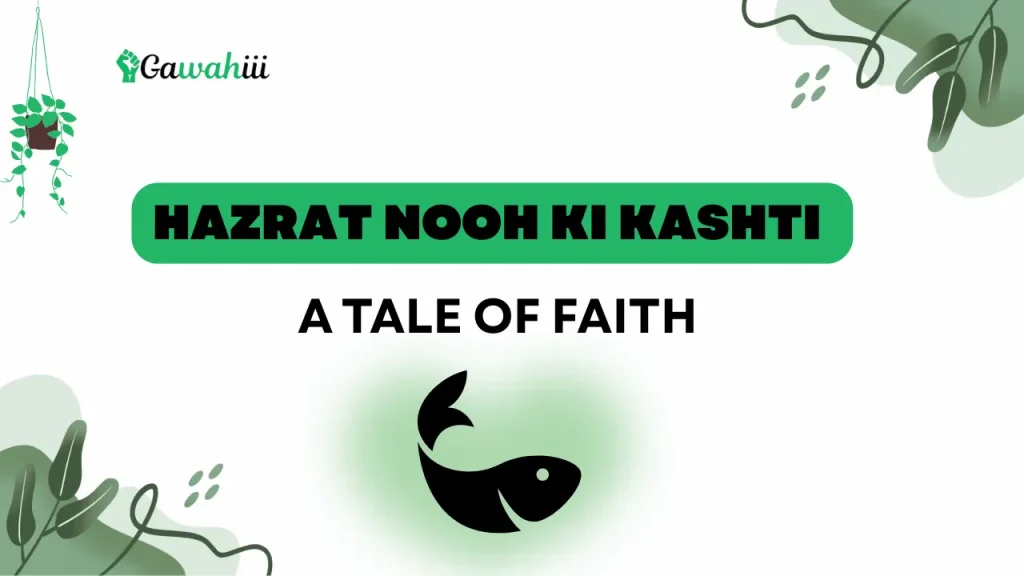Introduction
Hazrat Nooh’s (AS) Ark is considered among the best-known and most spiritually meaningful accounts in Islamic tradition. Its teaching goes beyond the borders of faith and gives wisdom about faith, patience, the importance of following commands, and responsive intervention from God. Despite mounting climate threats, spiritual uncertainties, and moral problems, the story of Hazrat Nooh’s Ark continues to be very relevant. It serves as a guide for trusting what God reveals, alerting us to the harm of becoming arrogant, and showing that rejection of prophetic messages will have consequences.
Here, you will find an extensive exploration of Hazrat Nooh ki kashti hat draws from the Quran, Hadith, historical reports, and modern insights. In this article, you will find information on the spiritual lessons, historical meanings, and practical uses of Hazrat Nooh’s story. No matter if you are interested in Islamic history, teaching your children about faith, or seeking personal guidance, you will find that this article delivers substantial and practical lessons with ease and clarity.
1.The Identity of Hazrat Nooh (AS)
- , whose full name is Nuh, appears throughout Islamic history.
- Hazrat Nooh (Noah, peace be upon him) was one of the very first prophets Allah sent to lead humanity to the right path. He was asked by Allah to antagonize the ancient polytheists and promote righteousness.
- He has his own named chapter in the Quran, Surah Nooh, and is also featured in Surah Hud and Surah Al-Mu’minoon.
- It is traditionally accepted in Islam that his message was spread over 950 years.
- He belongs to the category of five authentically determined prophets, according to Islamic tradition.
Key Facts:
- He came after a major number of generations that passed since Hazrat Adam (AS).
- Opposition and criticism were common among his people.
- He continuously reminded his people that Allah would bring a punishment on them if they did not repent.
The Mission and Message of Hazrat Nooh (AS)
Hazrat Nooh’s work concentrated on encouraging his community to believe in one God and to leave behind idolatry.
- He taught the message using both wisdom and humility while enduring all obstacles.
- He repeatedly exhorted his people to turn back to Allah and promised them that God’s mercy was available.
- He was confronted with greater and greater hostility until Allah informed him that his message would go unheeded.
Bullet Points:
- He was assigned to the mission for almost one thousand years.
- He presented strong rational proofs, emotional encouragement, and strong spiritual alerts.
- Hazrat Nooh’s steadfastness provides an example for all who carry out da’wah.
Building the Ark: Divine Command and Human Mockery
- As soon as Allah understood the people would not change their ways, Hazrat Nooh was ordered to start building an ark.
- Because construction happened on dry ground, others scoffed at him.
- Hazrat Nooh followed every command that Allah gave.
- The ark was created to hold pairs of every animal as well as believers.
Key Themes:
- Being obedient even when those around you make fun of you.
- Trust in unseen divine plans.
- Importance of preparation and foresight.
The Flood: A Universal Catastrophe and Divine Justice
- After the ark was finished, Allah sent a great flood as his punishment.
- Rain fell heavily, and the ground burst forth with water.
- Only the people who were on the ark survived.
- Noah’s son, who did not have faith, died when the floodwaters swallowed him.
Notable Points:
- It reflects the outcome of people’s unwillingness to accept a belief over a long period.
- Shows that fulfillment of spiritual and family obligations is essential.
- This episode stands as a valuable lesson about answering to God.
The Landing of the Ark and New Beginnings
- After the water had gone down, tradition holds that the ark found its resting place on Mount Judi, which is named in the Quran.
- The world changed fundamentally after what happened.
- Only those believers who made it through the disaster became the foundations of a revived and pure society.
- Nooh thanked Allah and proceeded to restore his prophetic mission in the land.
Table: Each tradition offers a different location where the Ark came to rest.
| Tradition | Believed Landing Site | Scriptural Reference |
|---|---|---|
| Islam | Mount Judi | Surah Hud (11:44) |
| Christianity | Mount Ararat | Genesis 8:4 |
| Historical Studies | Southeastern Turkey | Various archaeological theories |
Spiritual Lessons from Hazrat Nooh Ki Kashti
- There are many significant lessons for believers within this story.
- Faith in Adversity: The Quran and Hadith supply us with colorful details about this episode.
- Patience in Da’wah: Not quitting despite little apparent success.
- Warning Against Arrogance: Ignoring the warning of prophets brings about self-destruction.
Bullet Points:
- Importance of spiritual persistence.
- Humility in recognizing divine signs.
- The value of sincere repentance.
Hazrat Nooh Ki Kashti in the Quran and Hadith
- Islamic scriptures provide vivid details about this story.
- Entirely dedicated to his trials and persistent plea, Surah Nooh relates Nooh’s narrative.
- Nooh’s dialogues with his fellow citizens are described at length in Surah Hud.
- Traditions collected in the Hadith record the story of his ark along with the flood.
Key Verses:
- The divine instruction was, ‘O earth, take back all the water you have.’ (Quran 11:44)
- Our Prophet Muhammad (PBUH) stressed Nooh’s steadfastness and perseverance.
Symbolism and Moral Reflections
- Hazrat Nooh’s kashti should be interpreted spiritually as well as being a physical structure.
- Represents salvation through obedience.
- Symbolizes divine mercy and wrath.
- The ark is frequently considered a manifestation of faith, much like a way to protect people during hard times.
Spiritual Symbols:
- Water = trials and purification.
- Ark = Faith and obedience.
- Hope and renewal are symbolized by Mount Judi.
Historical and Archaeological Perspectives
- Many attempts have been made by expeditions to discover the remains of the ark.
- Some scientists say they have discovered wooden structures at the foot of Mount Ararat.
- Muslim tradition is united in linking Mount Judi to the ark’s final destination.
- Archaeology remains inconclusive but intriguing.
| Claim Type | Location | Credibility |
| Traditional Claim | Mount Judi | Quran-supported |
| Archaeological | Mount Ararat | Inconclusive |
| Mythical Theories | Various peaks | Speculative |
Relevance of Hazrat Nooh’s Story Today
- Today, the narrative is as important as ever in people’s lives.
- Climate Lessons: Caretaking of the natural world is important because neglecting it can lead to substantial problems.
- Spiritual Guidance: The key to salvation is strictly living by divine laws.
- Family & Society: Holding to faith requires effort at both an individual and group level.
Practical Takeaways:
- Maintain your commitment to faith whenever the world criticizes it.
- Take moral warnings seriously.
- Ensuring you are spiritually equipped helps you pass life’s trials.
Frequently Asked Questions
Where is Hazrat Nooh’s Ark now?
Islamic tradition says it landed on Mount Judi. Some researchers believe remnants may exist in modern-day Turkey.
What was Hazrat Nooh’s main message?
To worship one God and abandon false idols.
How long did Hazrat Nooh preach?
According to the Quran, he preached for 950 years.
Did Hazrat Nooh’s son survive the flood?
No. He refused to board the ark and drowned as a result.
Why is Hazrat Nooh’s story important today?
It teaches lessons on faith, patience, obedience, and the consequences of ignoring divine warnings.
Conclusion
Beyond being a story of history, Hazrat Nooh ki kashti is a practical teaching important to every Muslim’s spiritual life.
For those beginning to learn the foundations of Islamic tales as well as for seekers of higher spiritual insight, the meaning of this narrative is enduringly clear. Accept its teachings, relate its wisdom to those around you, and allow the ark to inspire you to live more reliably as a Muslim.
To go deeper into the subject, consult the Surahs Nooh and Hud together with a translation, or seek tafsir and scholarly accounts on reliable Islamic educational sites.







